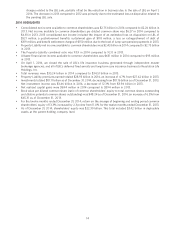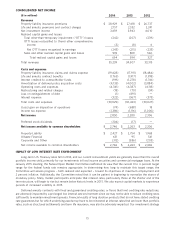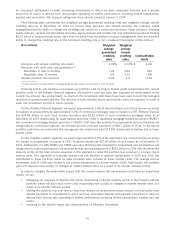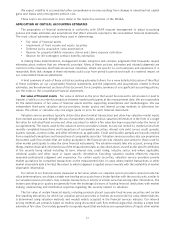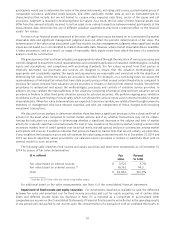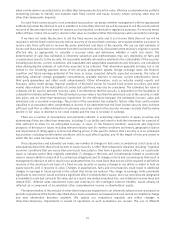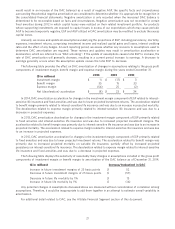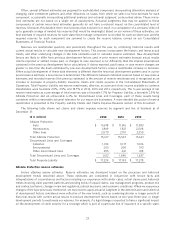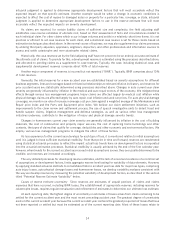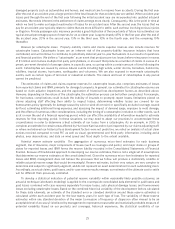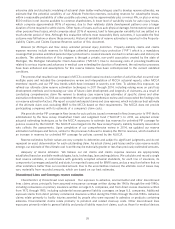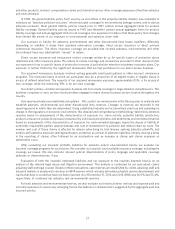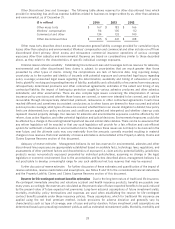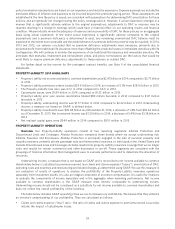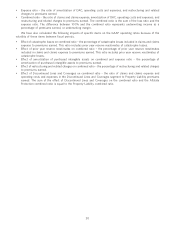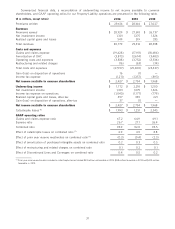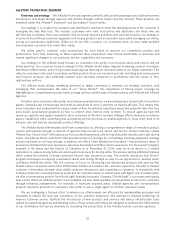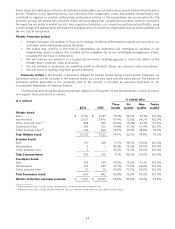Allstate 2014 Annual Report Download - page 124
Download and view the complete annual report
Please find page 124 of the 2014 Allstate annual report below. You can navigate through the pages in the report by either clicking on the pages listed below, or by using the keyword search tool below to find specific information within the annual report.actuarial judgment is applied to determine appropriate development factors that will most accurately reflect the
expected impact on that specific estimate. Another example would be when a change in economic conditions is
expected to affect the cost of repairs to damaged autos or property for a particular line, coverage, or state, actuarial
judgment is applied to determine appropriate development factors to use in the reserve estimate that will most
accurately reflect the expected impacts on severity development.
As claims are reported, for certain liability claims of sufficient size and complexity, the field adjusting staff
establishes case reserve estimates of ultimate cost, based on their assessment of facts and circumstances related to
each individual claim. For other claims which occur in large volumes and settle in a relatively short time frame, it is not
practical or efficient to set case reserves for each claim, and a statistical case reserve is set for these claims based on
estimation techniques described above. In the normal course of business, we may also supplement our claims processes
by utilizing third party adjusters, appraisers, engineers, inspectors, and other professionals and information sources to
assess and settle catastrophe and non-catastrophe related claims.
Historically, the case reserves set by the field adjusting staff have not proven to be an entirely accurate estimate of
the ultimate cost of claims. To provide for this, a development reserve is estimated using the processes described above,
and allocated to pending claims as a supplement to case reserves. Typically, the case, including statistical case, and
supplemental development reserves comprise about 90% of total reserves.
Another major component of reserves is incurred but not reported (‘‘IBNR’’). Typically, IBNR comprises about 10%
of total reserves.
Generally, the initial reserves for a new accident year are established based on severity assumptions for different
business segments, lines and coverages based on historical relationships to relevant inflation indicators, and reserves for
prior accident years are statistically determined using processes described above. Changes in auto current year claim
severity are generally influenced by inflation in the medical and auto repair sectors of the economy. We mitigate these
effects through various loss management programs. Injury claims are affected largely by medical cost inflation while
physical damage claims are affected largely by auto repair cost inflation and used car prices. For auto physical damage
coverages, we monitor our rate of increase in average cost per claim against a weighted average of the Maintenance and
Repair price index and the Parts and Equipment price index. We believe our claim settlement initiatives, such as
improvements to the claim review and settlement process, the use of special investigative units to detect fraud and
handle suspect claims, litigation management and defense strategies, as well as various other loss management
initiatives underway, contribute to the mitigation of injury and physical damage severity trends.
Changes in homeowners current year claim severity are generally influenced by inflation in the cost of building
materials, the cost of construction and property repair services, the cost of replacing home furnishings and other
contents, the types of claims that qualify for coverage, deductibles and other economic and environmental factors. We
employ various loss management programs to mitigate the effect of these factors.
As loss experience for the current year develops for each type of loss, it is monitored relative to initial assumptions
until it is judged to have sufficient statistical credibility. From that point in time and forward, reserves are reestimated
using statistical actuarial processes to reflect the impact actual loss trends have on development factors incorporated
into the actuarial estimation processes. Statistical credibility is usually achieved by the end of the first calendar year;
however, when trends for the current accident year exceed initial assumptions sooner, they are usually determined to be
credible, and reserves are increased accordingly.
The very detailed processes for developing reserve estimates, and the lack of a need and existence of a common set
of assumptions or development factors, limits aggregate reserve level testing for variability of data elements. However,
by applying standard actuarial methods to consolidated historic accident year loss data for major loss types, comprising
auto injury losses, auto physical damage losses and homeowner losses, we develop variability analyses consistent with
the way we develop reserves by measuring the potential variability of development factors, as described in the section
titled ‘‘Potential Reserve Estimate Variability’’ below.
Causes of reserve estimate uncertainty Since reserves are estimates of unpaid portions of claims and claims
expenses that have occurred, including IBNR losses, the establishment of appropriate reserves, including reserves for
catastrophe losses, requires regular reevaluation and refinement of estimates to determine our ultimate loss estimate.
At each reporting date, the highest degree of uncertainty in estimates of losses arises from claims remaining to be
settled for the current accident year and the most recent preceding accident year. The greatest degree of uncertainty
exists in the current accident year because the current accident year contains the greatest proportion of losses that have
not been reported or settled but must be estimated as of the current reporting date. Most of these losses relate to
24


